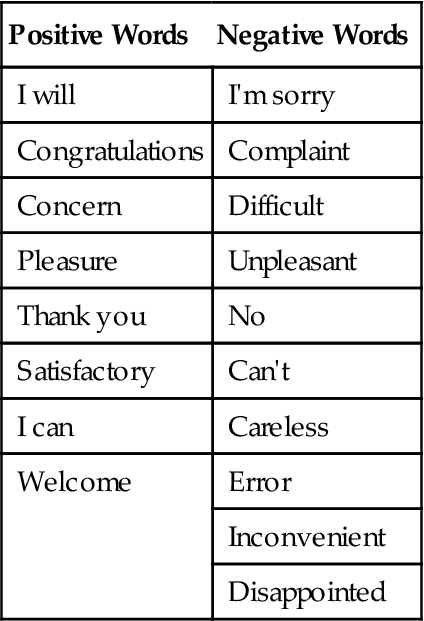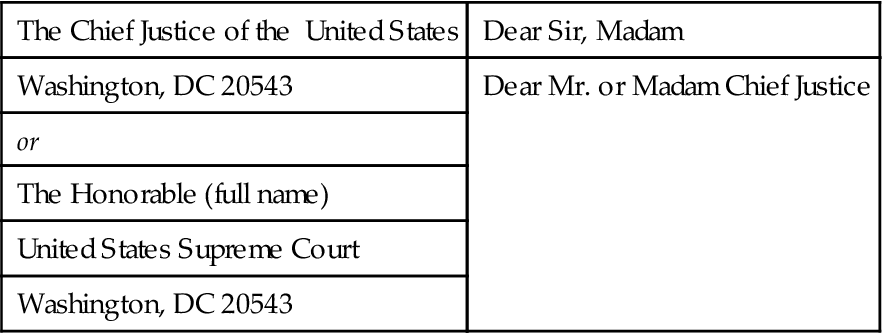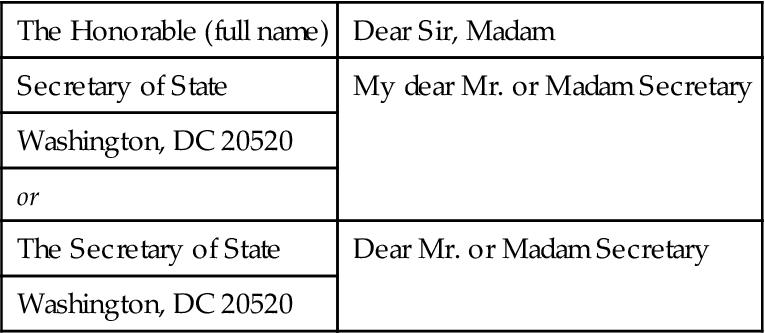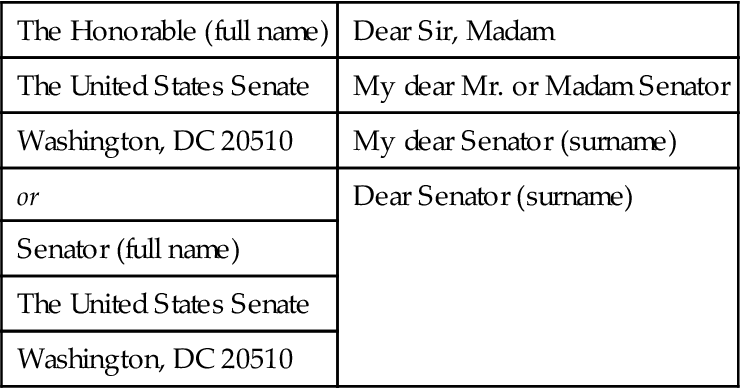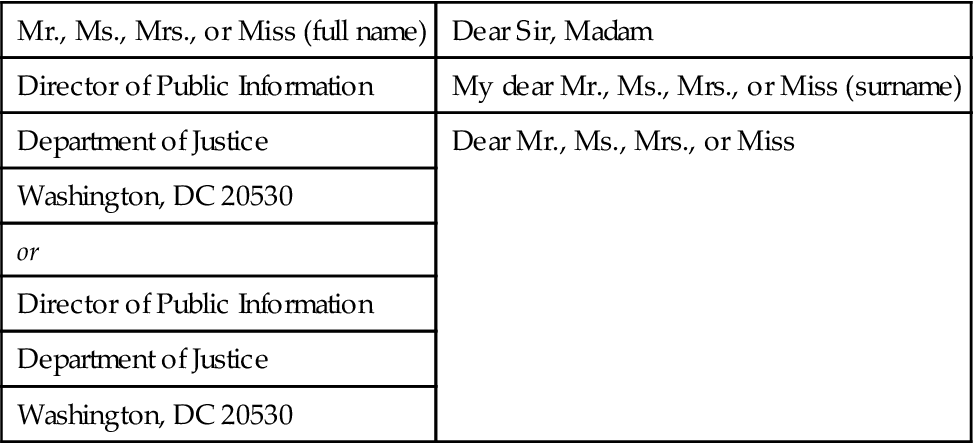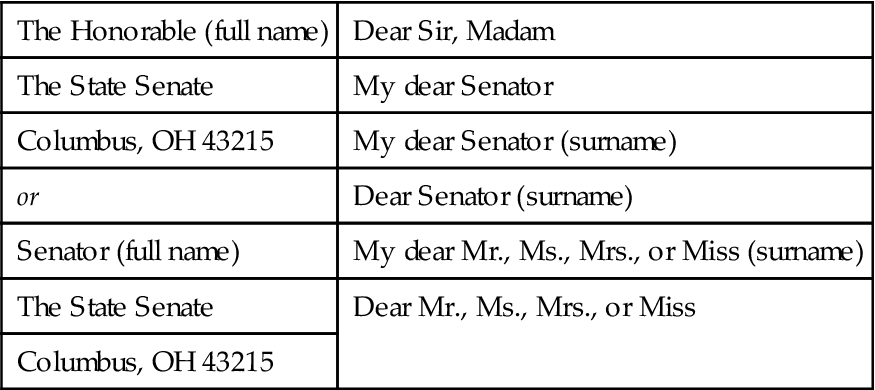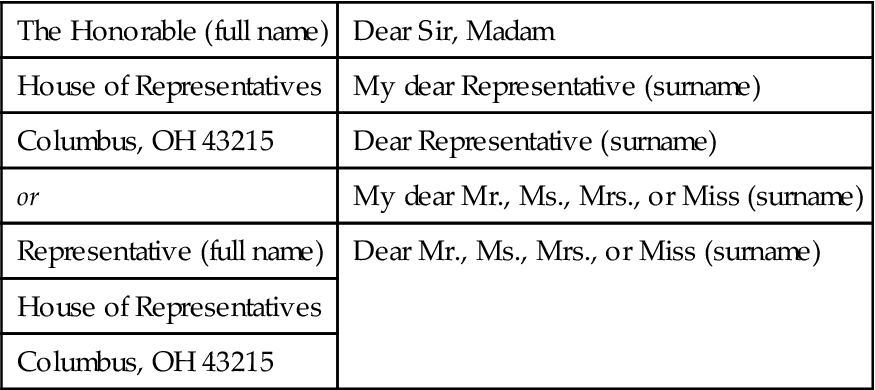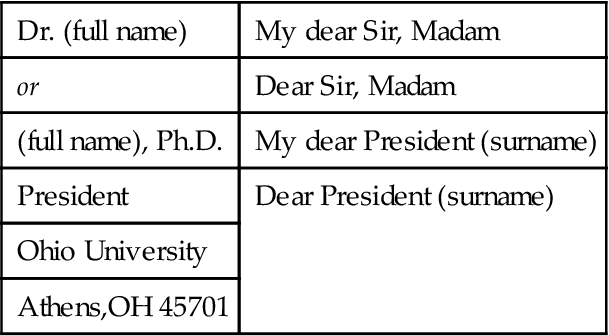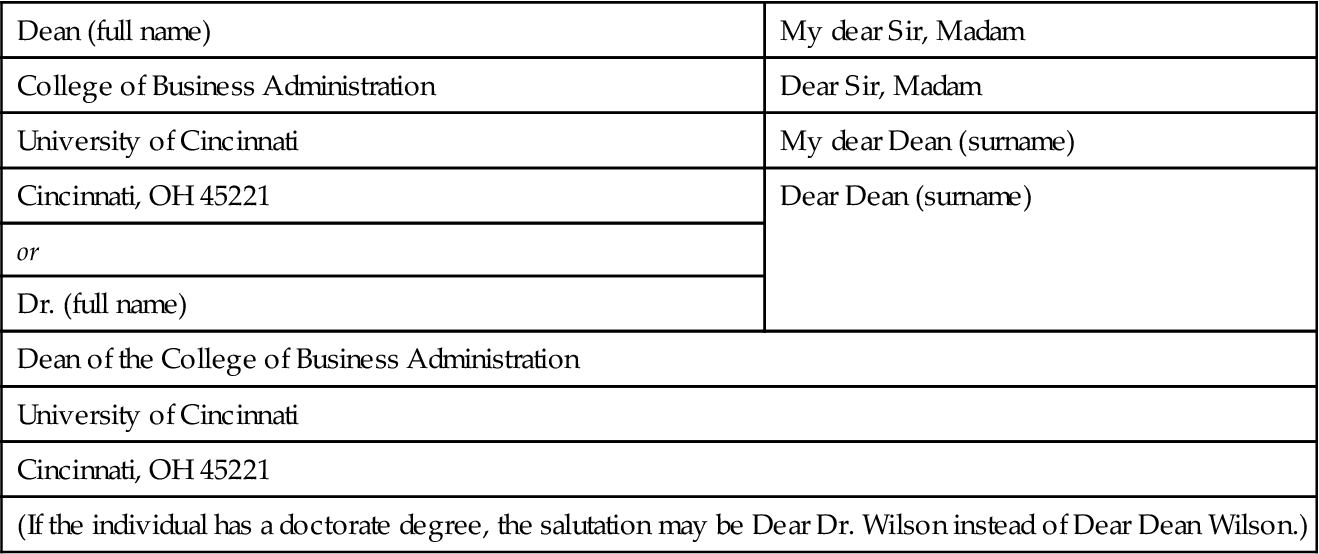Written Communications
LEARNING OUTCOMES
• Describe the various types of written communication in a dental office.
• Identify the characteristics of effective correspondence.
• Identify the parts of a letter.
• Review rules of punctuation and capitalization.
• Describe the basic steps for preparing written communication.
• Apply various formatting styles to written communication.
• Describe standard procedures for preparing outgoing mail.
• Observe ethical and legal obligations in written communication.
• Explain the use of e-mail in the dental office.
• Apply common business etiquette to the use of e-mail.
• Identify the classifications of mail.
• Identify special mail services.
• Explain the function of a postage meter.
Today one may ask if written communication is as important in the dental office as it has been in the past. The answer is a resounding yes. Because e-mail is such a widely used vehicle for communicating today, the administrative assistant will probably write more than in the past. Many professionals find themselves writing more than telephoning their colleagues.
Written communication in all of its forms remains extremely important. In addition to e-mail, the administrative assistant will use instant messaging via the Internet and write memorandums, letters, and reports. Effective written correspondence promotes good will for the office, whereas ineffectively written correspondence can cost the dental office greatly in unhappy patients and good will. The cost can include, but not limited to, loss of patients, profit, patient satisfaction, and good will.
Good business and professional writing should sound like a person talking to another person. Using an easy-to-read style makes the reader respond more positively to stated ideas. Make writing easier to read in two ways. First, make individual sentences and paragraphs easy to read so the reader can easily skim the first paragraph or read the entire document in as short a time as possible. Second, make the document visually pleasant and structure signposts that lead the reader through the document.
Good business and professional writing is closer to a conversation and less formal than the style of writing that has traditionally earned high marks on college essays and term papers. However, many dental professionals also use professional papers that are easy to read and use good visual impact.
Most people have several styles of talking, which they vary instinctively, depending on the audience. So it will be with writing in the dental office. A letter to a dentist regarding a professional technique or a letter to a dental supplier demanding better service may be formal, whereas an e-mail to a colleague will be informal and perhaps even chatty.
Chapter 7 examined the various types of documents generated in the dental office. Now it is time to review the importance of other types of written communication in a dental practice, specifically the use of letters, forms, and newsletters. These documents are all created by the administrative assistant for a variety of reasons. This chapter discusses the creation and production of written communication, how it is distributed, and how incoming written communication is processed, both in the manual and electronic form.
LETTERS
A variety of written documents are generated in the dental office, but none are as important as the letters that seek to enhance public relations with patients and professional colleagues. These letters should be original and create a professional image. Most important, these letters should be one that the administrative assistant is proud to mail from the office.
With the use of word processing in the dental office, the dreaded task of creating an original letter each time one is needed is eliminated. Today’s administrative assistant can have a supply of sample letters stored as templates in an electronic file. When necessary, the assistant can transform the sample into an original letter that is professional and can be personalized within minutes.
The types of written communication most commonly sent from a dental office include thank you notes for referral of patients, letters of appreciation, birthday or holiday greetings, congratulatory letters, sympathy messages, patient transfer letters or letters of consultation, recall notices, collection letters, order letters, and newsletters.
Thank You for Referral Letter
The dentist should be appreciative of the confidence expressed by a patient who refers a new patient to the office and should acknowledge such a referral with a personally signed letter. Although this letter should mention the name of the referred patient, it should never divulge any confidential information about the treatment. However, if this letter is to be sent to a physician or another dentist, a reference statement may be made about the patient’s diagnosis and/or prognosis, if this was discussed with the patient and the patient has signed the appropriate disclosure forms. Several examples of this type of thank you letter are shown in Figure 9-1. Note that the differences in content vary according to the situation.
Letter of Appreciation to a Cooperative Patient
A cooperative patient is often overlooked and taken for granted. Often one thinks only of the patient who creates frustration. A dentist should acknowledge a patient who is prompt for appointments, maintains a regular payment plan, and cooperates with prescribed home care plans. This is an opportunity to give sincere compliments. When the opportunity presents itself, try writing a letter as in Figure 9-2 on p. 155 and see how appreciative the patients are. A letter of appreciation should be sincere, state the purpose briefly, and be written as though conversing with the patient in person.
Birthday Letter and Holiday Greetings
Patients, especially children and older adults, like to be recognized on their birthdays. These letters should be cheerful and friendly. Figure 9-3 on p. 156 shows a letter that could be sent to an older adult on a special birthday. Another method of handling this form of public relations is to send a birthday card. Many professional stationers provide appropriate greeting cards for all occasions and dental specialties (see Figure 9-4 on p. 156).
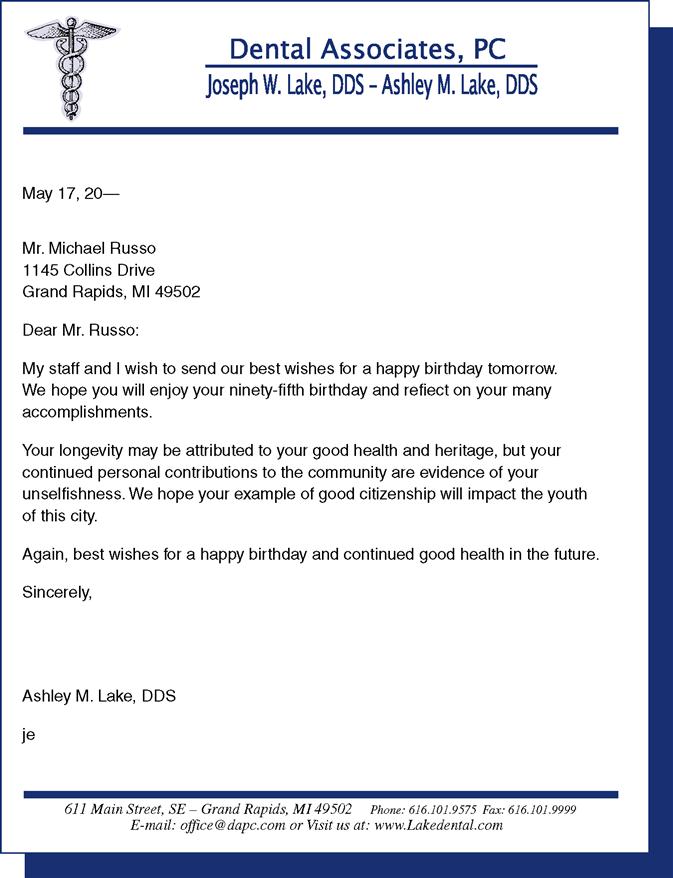
Congratulatory Letter
Through conversations with patients and via the daily newspaper, the administrative assistant may learn the outstanding achievements of patients. Such accomplishments should not go unnoticed by the dental office staff. A letter sent to congratulate a patient must be sent promptly. Include how the event was learned of and include a sincere expression of congratulations (see Figure 9-5 on p. 157). Congratulations can also be sent for the birth of a child, a wedding, or a graduation. A greeting card or brief letter is appropriate.
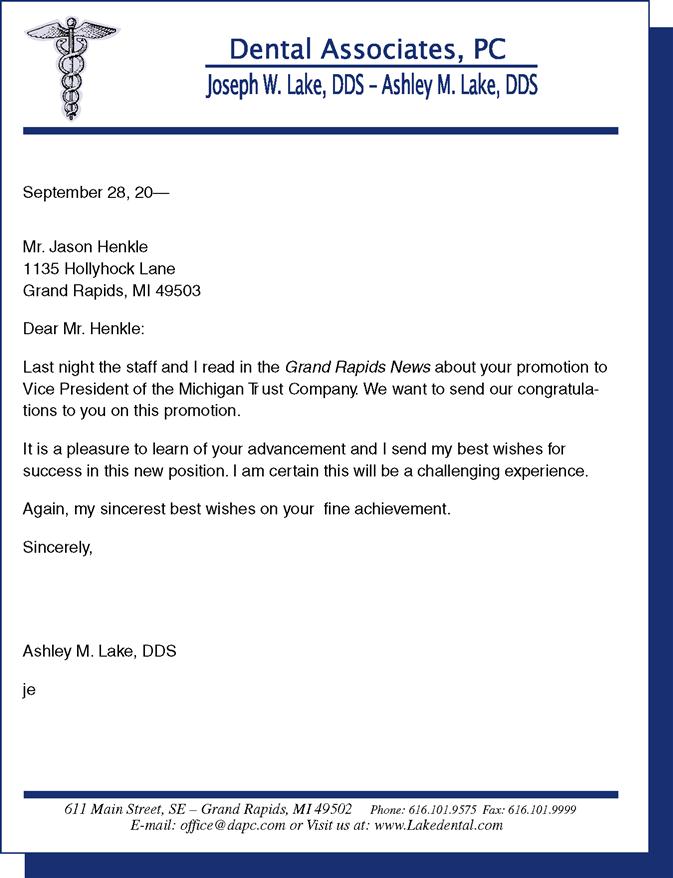
Referral for Consultation or Treatment
During the treatment of a patient, it is often necessary to call upon the services of a specialist. A series of letters may be sent between the two dental offices concerning the patient’s treatment. A good example of such an experience is the transfer of a patient to an orthodontist for treatment (see Figure 9-6 on p. 158). Figure 9-7 on p. 159–161 shows examples of several forms of communication that might be used during a patient’s treatment. Note that the specialist’s office has used a basic format that provides information about the patient’s treatment. This letter can be stored electronically, or a pre-prepared form can be used in a specialty office, such as an orthodontics office, because there is a large patient volume and a similarity of basic treatment. Regardless of the type of form used, note that in each case the patient’s name is referenced, the message is brief, and each tooth or condition is diagrammed or written out completely to avoid error in interpretation.
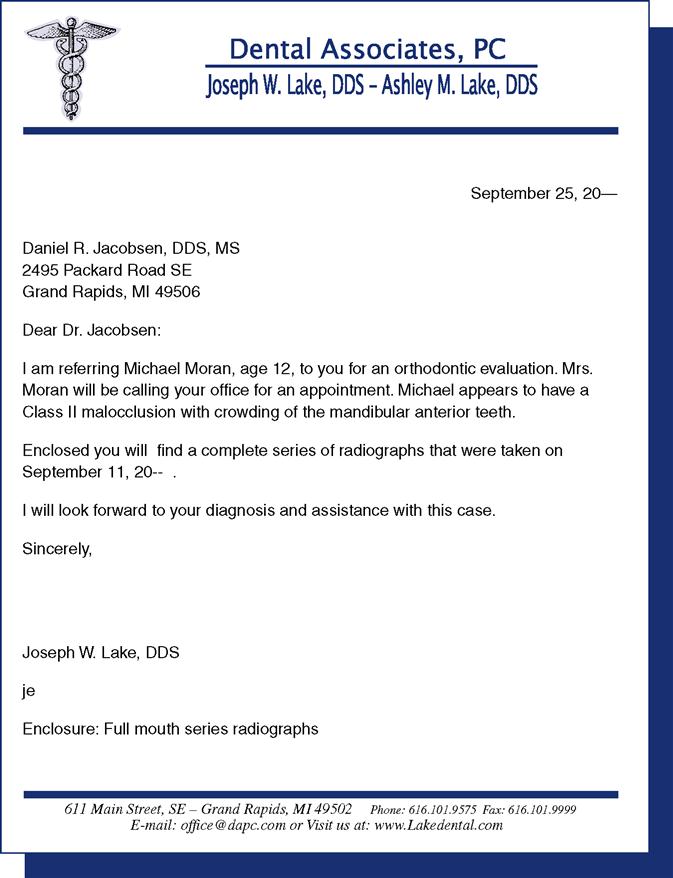
Sympathy Message
Many people find it difficult to express sympathy in a letter. Therefore one of the best ways to handle this difficult situation is to send a sympathy card. It is the unexpected message that often means a great deal to family members in their time of grief.
Miscellaneous Letters
Many letters are not public relations letters and are not included in this chapter. Specific examples of recall, broken appointment, and collection letters are discussed in the chapters that specifically address each of these topics.
SELECTING STATIONERY SUPPLIES
If the administrative assistant begins working in an established dental practice, the stationery supplies will already be available. However, he or she may have to choose business supplies if asked to order them. Many of these supplies are listed in Chapter 6.
The office stationery (letterhead) is usually selected on the basis of simplicity, neatness, and quality. Bond paper, because of its quality, is often used. It can be made from all-cotton fiber (sometimes called rag), all-sulfite (a wood pulp), or any proportion of the two. High-cotton fiber bond indicates quality and prestige, and it ages without deterioration or chemical breakdown.
The following information may be used as a guide for future stationery needs:
CHARACTERISTICS OF AN EFFECTIVE LETTER
Effective letters that generate good public relations have certain common elements. Keep in mind that direct, simple writing is easier to read. The best word depends on context: the situation, the purpose, the audience, and the words used. Following are some general guidelines:
• Use active verbs most of the time. This is common in writing for a job application or referring a patient to a specialist. If the verb describes something that the subject is doing, the verb is active. If the verb describes something that is being done to the grammatical subject, the verb is passive.
Active: I recommend that the patient’s third molar be removed.
Passive: It was recommended by me for the patient to have the third molar removed.
Active: I can expose digital radiographs.
Passive: Digital radiography is something I could do.
• Tighten the writing. Eliminate words that say nothing. Combine sentences to eliminate unnecessary words. Put the meaning of the sentence into the subject and verb. Cut words if the idea is already clear from other words in the sentence. Substitute single words for wordy phrases.
Wordy: Keep this information in the patient’s file for future reference.
Tighter: Keep this information for reference.
or: File this information.
Phrases beginning with of, which, and that can often be shortened.
Wordy: The issue of most importance
Tighter: The most important issue.
Wordy: The estimate that is enclosed
Tighter: The enclosed estimate
Wordy: It is the case that Registered Dental Assistants are more qualified clinicians in the office.
Tighter: Registered Dental Assistants are more qualified clinicians in the office.
A simple sentence has one main clause:
We will open a new office this month.
A compound sentence has two main clauses joined with and, but, or, or another conjunction. Compound sentences are used best when the ideas in the two clauses are closely related.
[Clause 1]We have hired three new dental assistants, and [Clause 2]they will complete their orientation next week.
[Clause 1]We hired a new intern, but [Clause 2]she will be unable to begin work until the end of the month.
Complex sentences have one main and one subordinate clause; they are good for showing logical relationships.
[Subordinate clause] When the new office opens, [Main clause] we will have an open house for local dentists and offer refreshments and door prizes.
[Subordinate clause] Because we already have a strong patient base in Livingston County, [Main clause] we expect the new office will be as successful as the Ann Arbor office.
• Use parallel structure: Parallel structure puts words, phrases, or clauses in the same grammatical and logical form. Clarity eliminates long, meaningless words and uses language that the reader will understand. Thus it is certain that each statement will not be misinterpreted.
Nonparallel: The position is prestigious, challenging, and also offers good money.
Parallel: The position offers prestige, challenge, and good money.
Nonparallel: The steps in the planning process include:
Determining the objectives
An idea of who the reader is
A list of the facts
Parallel: Determine the objective
Consider the reader
Gather the facts
• Put your readers in your sentences: Use second person pronouns (you) rather than third person (he, she, one) or first person (I) to give your writing a greater team approach. The “you” approach to letter writing requires the writer to place the reader at the center of the message. When writing the letter, put yourself in place of the reader.
Third person: References for patients in this office are made by our office manager, and the patient will be contacted as soon as the appointment has been confirmed with the specialist.
Second person: Once you are referred to a specialist, you will receive a confirmation of your appointment from our office manager.
In addition to the ideas presented in the preceding, the administrative assistant should review the basic characteristics of effective correspondence. These factors should be used in a review of the letter before it is sent. Remember that the letter sent from the dental office is representative of the quality of work or treatment produced in that practice and should contain the following characteristics:
• Completeness: Include all necessary data the reader needs to make a decision or take action.
• Conciseness: State the information briefly.
• Courtesy: Use good manners for good public relations. Don’t make derogatory statements.
• Neatness: Avoid smudges, tears, or wrinkles.
• Positive language: Use positive words that indicate helpfulness and caring (Box 9-1).
< ?comen1?>
PARTS OF A BUSINESS LETTER
A review of the parts of a business letter and the proper placement and purpose for each part is appropriate before selecting a letter style creating the letter. Most business letters contain the following parts:
• Inside address (letter address)
• Body
• Special notations such as attention line, subject line, or enclosures
When using most word processing software, many preformatted letter styles are available. Dates are automatic, and in most systems alignment and letter parts are already defined.
Date Line
The date line contains the date the letter is keyboarded. When using printed letterhead stationery, the date usually begins a double space below the lowest line of the letterhead. (The letterhead usually takes up about 2 inches, but this may vary depending on the style and design of the letterhead.) Many times the length of the letter determines whether the heading should be started lower on the paper; good judgment is needed. When keyboarding a personal business letter, the individual’s return address is placed as the first two lines directly above the date line. The date line can be affected by the length of the letter. When using the computer, you may go to “Print Preview” to check the appearance of the letter. Necessary changes can be made before printing. General guidelines that relate to letter length are shown in Box 9-2.
Inside Address
The inside address provides all of the information for mailing the letter. The letter address should match the envelope address. When using word processing, the envelope often is addressed from the letter address by a minor key function on the computer. The information to be included is the recipient’s name, the name of company (if appropriate), street number and name, city, and zip code. Three lines of space are left between the date and the first line of the letter address.
Use titles preceding the individual’s name (Mr., Mrs., Ms., or Dr.). Do not use a double title, such as Dr. L. B. Crown, D.D.S.; this is redundant. An official title, such as President, may follow the name, for example, Ms. M. P. Coleman, President. The person’s official title is often placed on the second line if it helps to balance the inside address lines. The city, state, and zip code are placed on the last line. The appropriate two-letter state abbreviation should be set in capital letters without a period. Leave two spaces after the abbreviation before entering the Zip code.
Salutation
The salutation formally greets the reader. If the writer wishes the letter to be directed to an individual within a firm, it is acceptable to use an attention line. The salutation line should begin one double space below the letter address and should be even with the left margin. If you are writing to an individual, the most appropriate salutation is the individual’s name. For example, if the letter is addressed to Mr. Ted Monroe, the salutation would be Dear Mr. Monroe. The salutation can be altered to be Dear Ted if the dentist is a close friend of the recipient. This change in formality should be recognized before keyboarding the letter. Special situations occur when the letter is to be sent to unknown individuals or more than one person. Suggestions for salutations to be used in common situations are shown in Box 9-3, A. Addresses and salutations used for governmental and academic officials are shown in Box 9-3, B.
Stay updated, free dental videos. Join our Telegram channel

VIDEdental - Online dental courses


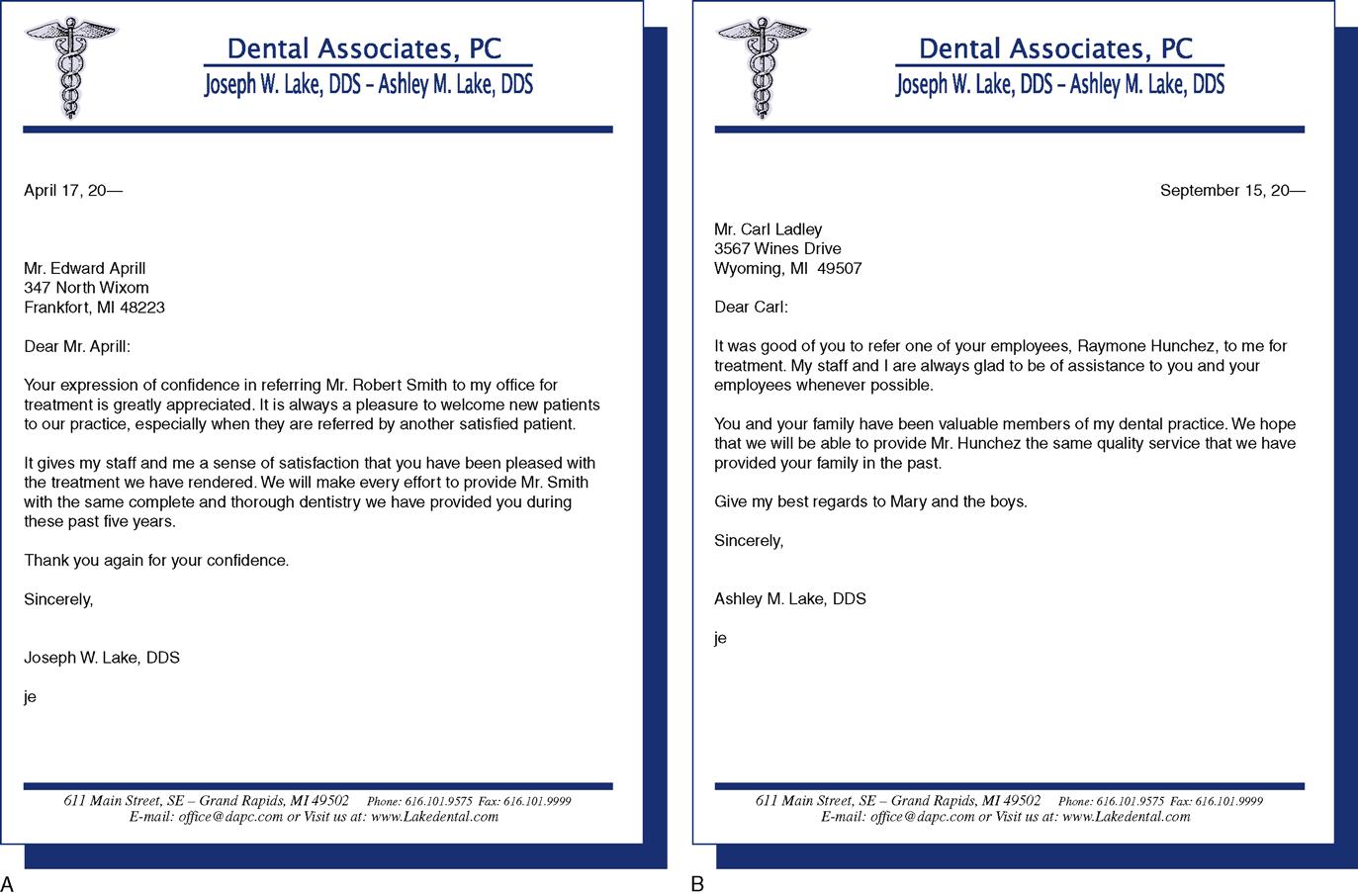
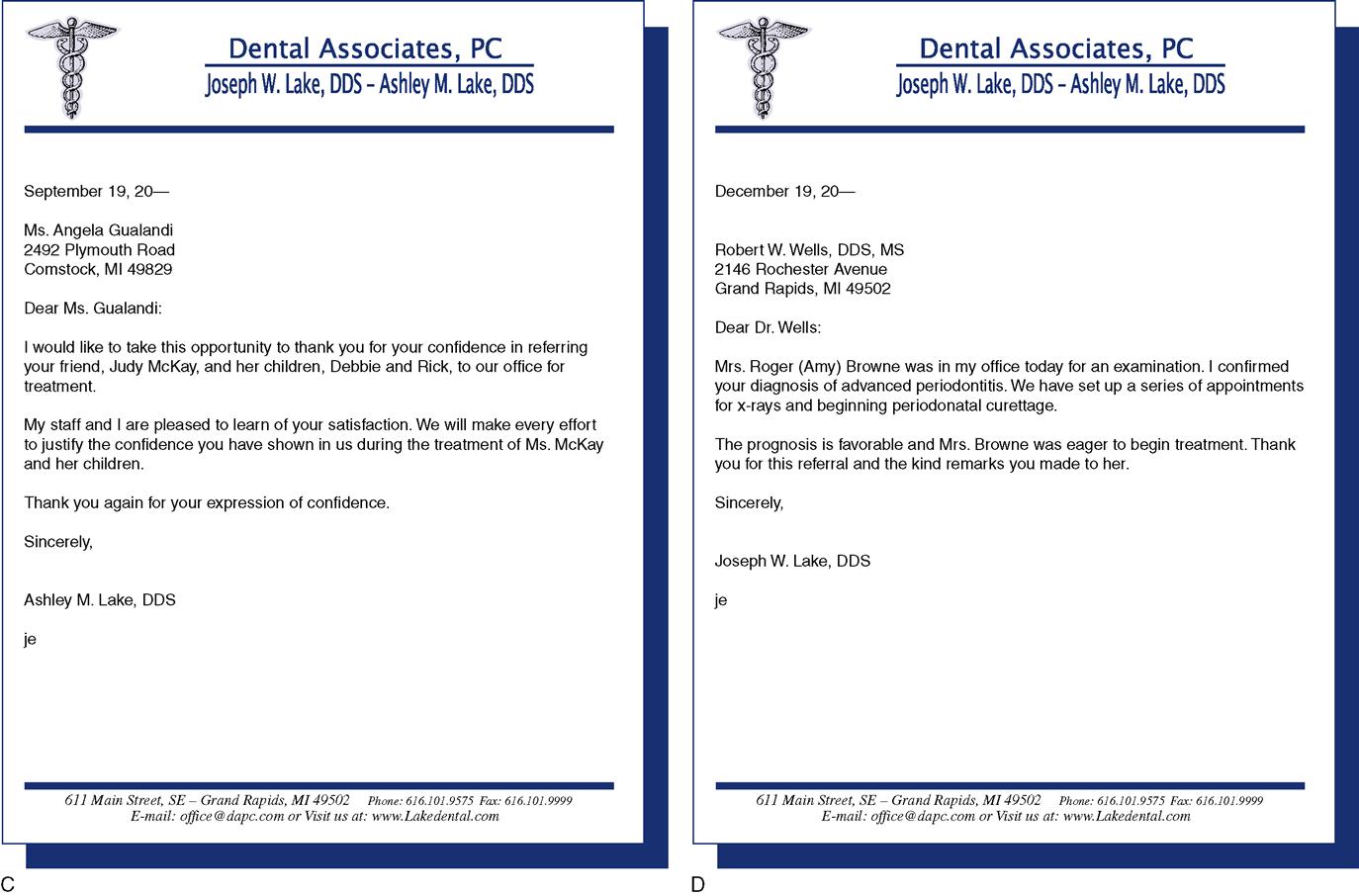
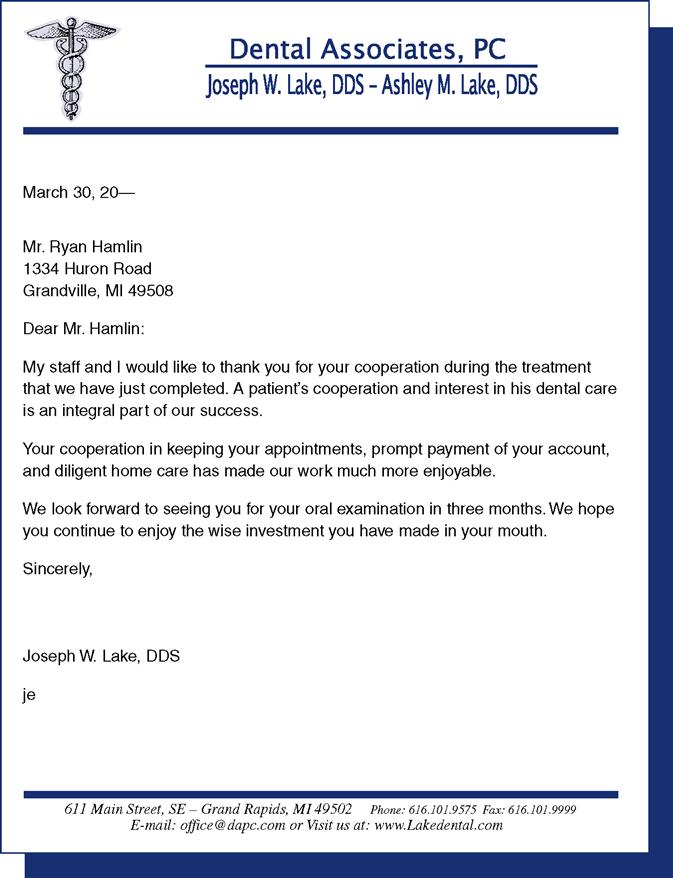
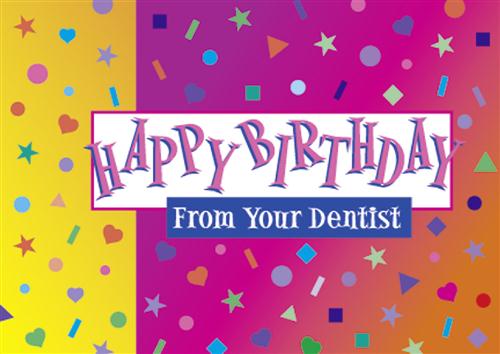
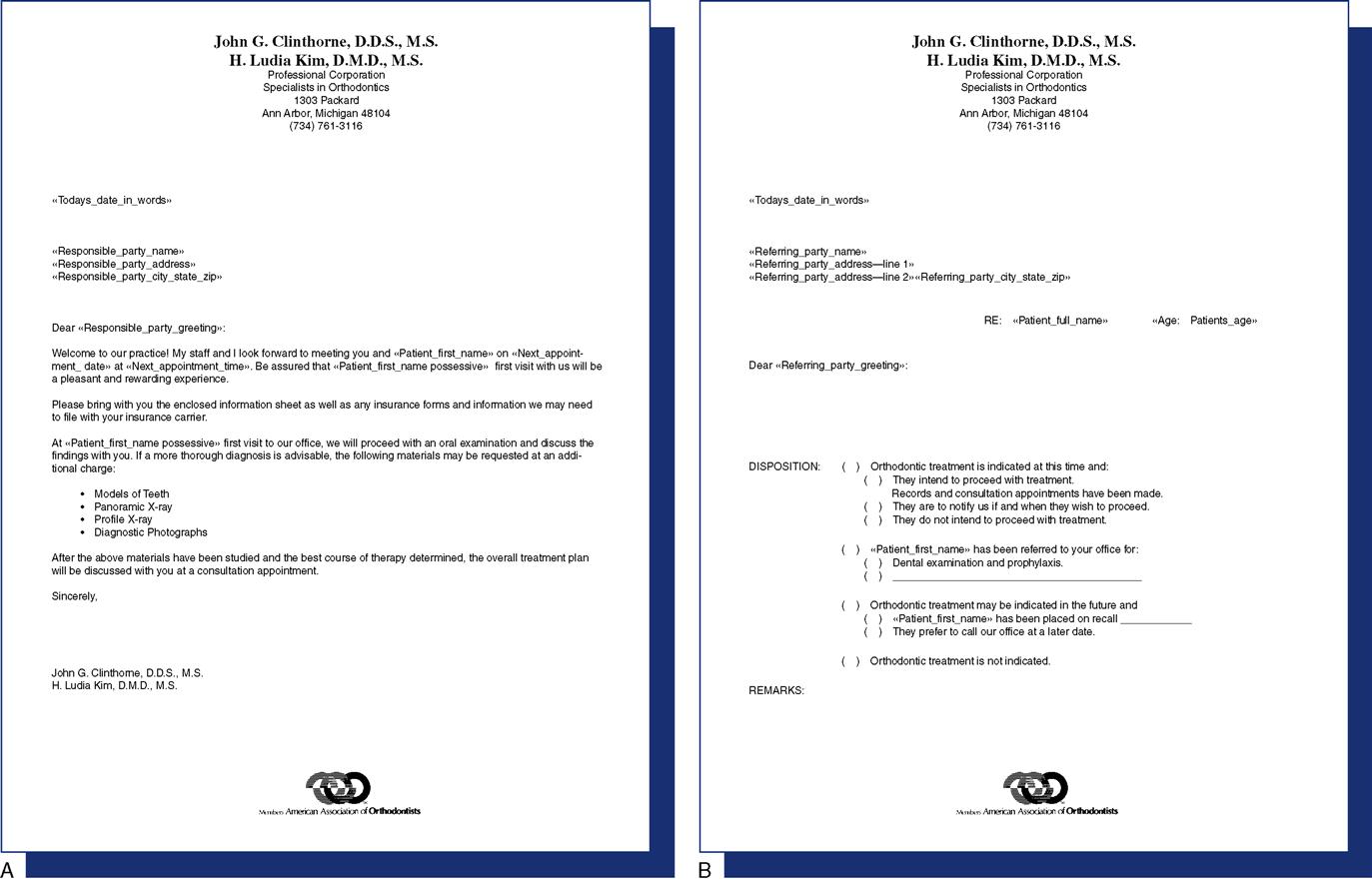
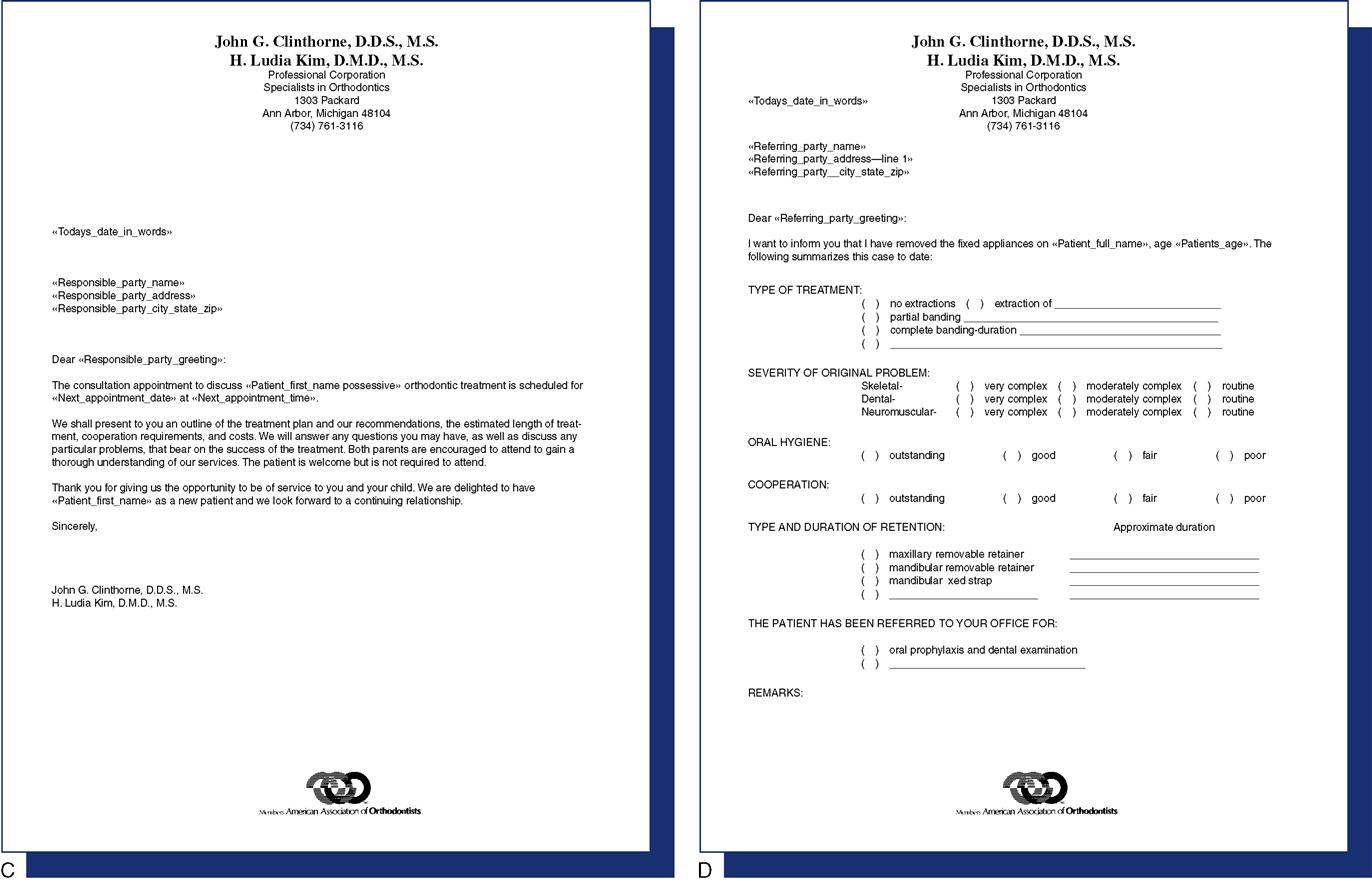

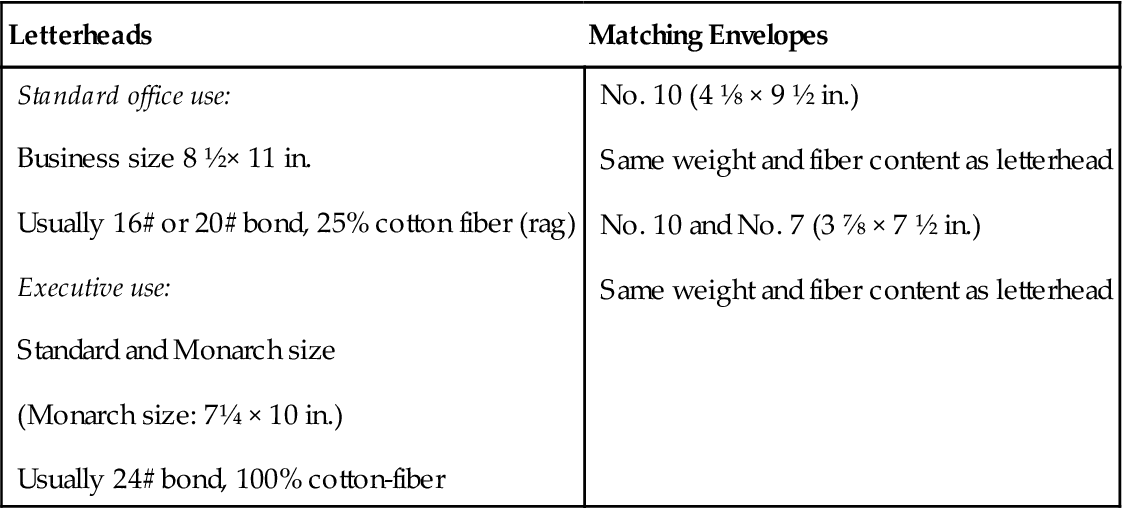
 Practice Note
Practice Note